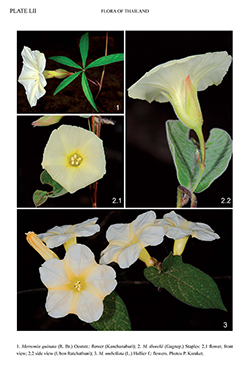e-Flora of Thailand
Volume 10 > Part 3 > Year 2010 > Page 444 > Convolvulaceae > Merremia
14. Merremia umbellata (L.) Hallier f.wfo-0001297308
Bot. Jahrb. 16: 552. 1893; Ooststr., Blumea 3: 333. 1939; Fl. Males. ser. 1, 4: 449. 1953; Kerr, Fl. Siam. Enum. 3(2): 6. 1954; Songkhla & Khunwasi, Thai Forest Bull. (Bot.) 20: 57, 84–85. 1993.— Convolvulus umbellatus L., Sp. Pl. 155. 1753. Plate LII: 3.
Accepted Name : Camonea umbellata (L.) A.R.Simões & Staples
Bot. J. Linn. Soc. 183: 583. 2017.
Synonyms & Citations :
Description : Perennial herbaceous twiners or creepers, axial parts softly whitish puberulent (or glabrate); stems rooting at nodes. Leaves ovate, ovate-oblong, or oblong-lanceolate, 3.5–14.5 by 1.3–10 cm, softly whitish puberulent, undersurface more densely so, base cordate, rarely hastate, apex emarginate, acute to acuminate; petiole 1–6 cm, base with 2 tiny stipules. Inflorescences umbelliform cymes, usually 3–40-flowered; peduncle (0.5–)2–5(–12) cm; bracts minute, early deciduous; pedicel 10–20(–30) mm, puberulent. Flower: sepals strongly convex, unequal; outer 2 shorter, obovate, 5–8 mm, abaxial surface pubescent (rarely glabrescent), base tapering cuneate, apex emarginate or truncate, mucronulate, inner sepals 6–9 mm, margin scarious; corolla funnelform, 2.5–4 cm, white or yellow, midpetaline bands whitish pubescent apically, limb slightly lobed; stamens included, anthers not twisted; pistil included, ovary glabrous or apex sparsely pubescent. Capsule conical-ovoid, 9–12 by 6–8 mm, yellowish brown, glabrous or apex sparsely pubescent, apiculate. Seeds ovoid-trigonous, 4–5 mm, black, densely yellowish hirsute.
Thailand : NORTHERN: Mae Hong Son, Chiang Mai, Nan, Lampang, Phrae, Phitsanulok; NORTH-EASTERN: Nong Khai; EASTERN: Chaiyaphum, Nakhon Ratchasima, Surin, Si Sa Ket, Ubon Ratchathani; SOUTH-WESTERN: Kanchanaburi, Prachuap Khiri Khan; CENTRAL: Lop Buri, Saraburi, Krung Thep Maha Nakhon (Bangkok); SOUTH-EASTERN: Chachoengsao, Chon Buri, Rayong, Chanthaburi, Trat; PENINSULAR: Chumphon, Ranong, Surat Thani, Phangnga, Nakhon Si Thammarat, Phatthalung, Trang, Songkhla, Yala, Narathiwat.
Distribution : Throughout tropical America (type), tropical eastern Africa, Nepal, India, Sri Lanka, Bangladesh, Myanmar, China, Laos, Cambodia, Vietnam, Malaysia, Singapore, Indonesia, the Philippines, New Guinea, Pacific Islands, Australia.
Ecology : Clearings, deforestsed areas, and vacant land in villages, mixed deciduous forests, evergreen hill forests, swamp margins, secondary scrub, 25–1,200 m alt. Flowering: January–March, October–December; fruiting: January, February, October, December.
Vernacular : No wai phai (นอไวไพ้)(Karen-Kanchanaburi); phak bung (ผักบุ้ง)(Prachuap Khiri Khan); chingcho khao (จิงจ้อขาว)(Chon Buri); thao dok ban tum (เถาดอกบานตูม)(Trat); en (เอน)(Surat Thani); buran (บุหรัน), yan khon (ย่านขน)(Nakhon Si Thammarat); a-ka kho-lae (อกาคอแล)(Malay-Narathiwat).
Notes: Van Ooststroom (1953) recognized Asian and Malesian plants of Merremia umbellata as subsp. orientalis (Hallier f.) Ooststr., Fl. Males, ser. 1, 4: 449. 1953, a taxonomic concept I have long agreed with. However, after seeing the considerable variability in SE Asian specimens, particularly those from Indochina, I hesitate to include all this variability within subsp. orientalis. Until a more detailed study of the variability can be made, and appropriate infraspecific taxa recognized, I am simply calling all Thai and SE Asian specimens M. umbellata. This is an extraordinarily polymorphic species, in the past much confused with M. kingii and M. bambusetorum, though now that adequate material is at hand the differences between these three species are somewhat clearer. Merremia umbellata can be recognized by its whitish puberulent axial parts, especially the pedicels; the crowded, umbelliform inflorescences (the secondary and tertiary branches short or none); the unequal sepals, with the outer two shorter, obovate, tapering to narrow bases between which the inner sepals are visible. Generally, the flowers of M. umbellata are smaller and there are more of them per inflorescence than in M. bambusetorum and M. kingii, though the overlap is undeniable.

